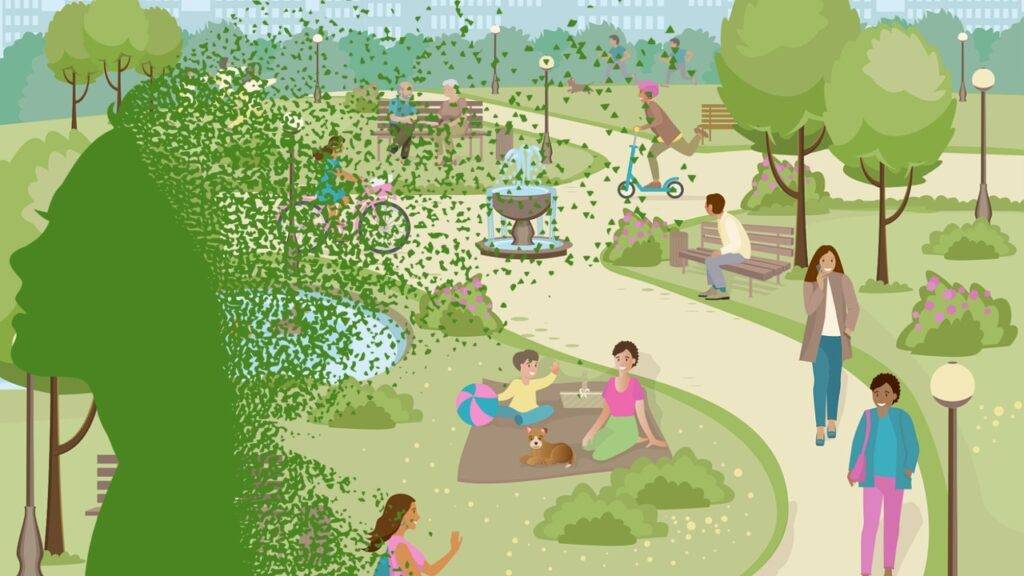
In bustling urban landscapes where concrete jungles dominate the scenery can take a toll on mental health. Stress, anxiety, and depression have become pervasive concerns, prompting researchers and city planners to seek innovative solutions to enhance well-being. With the number of towering skyscrapers and busy streets, there lies a simple yet powerful remedy – green spaces. Over the years, numerous studies have revealed a positive correlation between green spaces and mental health. In addition, the transformative effects of nature on our psychological well-being are well correlated.
Green Spaces and Their Significance
Green spaces encompass a diverse range of natural environments. These areas can be agriculture, parks, gardens, green rooftops, and extension forestry. Green spaces offer a sanctuary of nature amidst the hustle and bustle of city life. It provides opportunities for relaxation, recreation, and rejuvenation to communities.
The positive impact of green spaces on mental health has garnered significant attention from researchers and mental health professionals alike. Studies have consistently shown that access to green spaces has a multitude of benefits for our psychological well-being.
The Stress-Reducing Power of Green Spaces
One of the most prominent advantages of green spaces is their ability to reduce stress levels. Spending more time in natural settings has been found to lower salivary cortisol and alpha-amylase concentrations. These hormones help to reduce physiological stress. This observation highlights the stress-reducing potential of green spaces in our daily lives.
Enhanced Cognitive Function and Attention Restoration
Green spaces have a remarkable impact on cognitive function and attention restoration. The natural tranquility and beauty of green environments help in refocusing our minds. In addition, it facilitates us to recover from mental fatigue caused by urban stimuli. A study conducted at the University of Michigan found that walking in nature for just 20 minutes significantly improved attention and memory performance compared to walking in an urban setting. Therefore, green spaces can offer an opportunity to recharge our mental batteries, enhancing our cognitive abilities and productivity.
The Mood-Boosting Effect of Nature
In addition to reducing stress and improving cognitive function, green spaces have a profound impact on our mood. Moreover, spending time in nature led to an increase in positive emotions and a reduction in feelings of anger and sadness. Therefore, the calming and serene atmosphere of green spaces uplifts spirits, fosters emotional well-being, and acts as a natural antidepressant.
Promoting Physical Activity and Well-being
Green spaces also play a crucial role in promoting physical activity and overall well-being. The availability of outdoor spaces encourages people to engage in recreational activities, such as walking, jogging, cycling, and yoga. Moreover, regular physical activity has numerous benefits for mental health, including the release of endorphins (neurotransmitters) that improve mood and reduce feelings of pain. Additionally, exposure to nature during physical activity further enhances the positive effects on mental well-being.
Psychological positive effects of green spaces
- The Attention Restoration Theory, proposed by Rachel and Stephen Kaplan, suggests that natural environments provide a “restorative” experience for our cognitive senses. Nature offers a respite from the constant demands of urban life, allowing our attention to recover and our minds to recharge.
- The Stress Reduction Theory posits that exposure to green spaces elicits a relaxation response, reducing the physiological and psychological effects of stress. The calming and soothing attributes of nature counter the hectic and stressful aspects of urban environments.
- The Biophilia Hypothesis, introduced by Edward O. Wilson, proposes that humans have an innate connection to nature due to our evolutionary history. The presence of green spaces fulfills this inherent need, leading to improved mental well-being and overall life satisfaction.
Increasing Green Spaces to Urban Environments
Integrating green spaces into urban planning and design is pivotal to harnessing their mental health benefits. Cities that prioritize the creation and preservation of green areas offer their residents an opportunity to connect with nature regularly. Public parks, community gardens, and green corridors provide accessible havens of greenery, promoting a healthier and happier urban population.
While the positive correlation between green spaces and mental health is well-established, it is crucial to address challenges related to limited access, maintenance, and sustainability. Urban planners and policymakers must work together to ensure equitable distribution of green spaces, especially in underprivileged areas where access to nature may be scarce. Additionally, sustainable maintenance practices are essential to preserve these natural sanctuaries for future generations.
Several cities around the world serve as inspiring examples of successful green space integration. For example, Singapore city has transformed into a lush urban paradise. With an abundance of parks, gardens, and green corridors, the city embraces nature while maintaining its status as a bustling metropolis. Another example is Copenhagen where a perfect balance between urban development and greenery has been maintained. Residents enjoy access to extensive green spaces, fostering a sense of well-being and environmental consciousness.
Conclusion
Based on the ongoing discussion it is clear that green spaces have a profound positive correlation with mental health. Nature’s healing power and psychological mechanisms play natural and accessible solutions to combat stress, anxiety, and depression in our increasingly urbanized world. By prioritizing the integration of green spaces into urban planning, fostering equitable access, and promoting sustainable practices, we can create cities that nurture both physical and mental well-being. As we move forward, let us embrace the beauty and serenity of green spaces, for they hold the key to a healthier and happier urban future.

